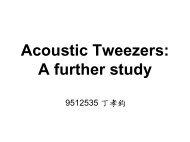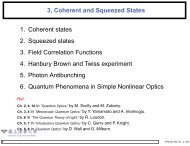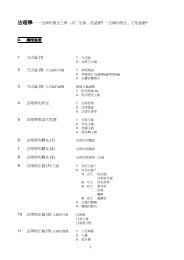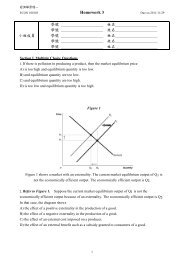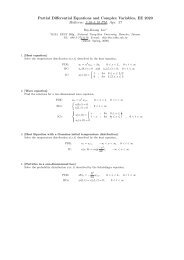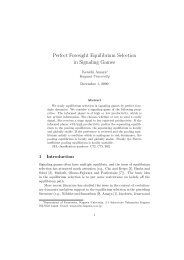Wave Optics
Wave Optics
Wave Optics
You also want an ePaper? Increase the reach of your titles
YUMPU automatically turns print PDFs into web optimized ePapers that Google loves.
Optoelectronic, 2007 – p.1/23
General <strong>Optics</strong><br />
Optoelectronic, 2007 – p.2/23
<strong>Wave</strong> <strong>Optics</strong><br />
Ray optics is wave optics for infinitly small wavelength<br />
<strong>Wave</strong> optics:<br />
Plane waves<br />
Spherical waves<br />
Interference<br />
Diffraction<br />
Gaussian beams<br />
Optoelectronic, 2007 – p.3/23
light travels in form of waves<br />
Postulates of ray optics<br />
optical medium is characterized by a quantity n<br />
c = c0<br />
n ,<br />
optical wave satisfies wave equation of type<br />
∇ 2 u − 1<br />
c 2<br />
∂2 = 0,<br />
∂t2 wave equation is linear - superposition<br />
if u1 and u2 is solution then also a1u1 + a2u2,<br />
optical intensity, I(r, t) = 2〈u2 (r, t)〉,<br />
i.e. averaging over times longer than 1 optical cycle,<br />
optical power, P(t) = <br />
I(r, t)dA,<br />
A<br />
Optoelectronic, 2007 – p.4/23
<strong>Wave</strong> equations<br />
For a source-free medium, ρ = J = 0,<br />
When ∇ · E = 0, one has wave equation,<br />
∇ × (∇ × E) = −µǫ ∂2<br />
E,<br />
∂ t2 ⇒ ∇(∇ · E) − ∇ 2 E = −µǫ ∂2<br />
E.<br />
∂ t2 ∇ 2 E = µǫ ∂2<br />
E<br />
∂ t2 which has following expression of the solutions, in 1D,<br />
with<br />
E = ˆx[f+(z − vt) + f−(z + vt)],<br />
<br />
ǫ<br />
H =<br />
µ ˆy[f+(z − vt) − f−(z + vt)],<br />
µǫ = µ0ǫ0(1 + χ) = n2<br />
,<br />
c2 Optoelectronic, 2007 – p.5/23
1D wave equation,<br />
Plane waves<br />
which has the solutions of<br />
∂2 ∂2<br />
∂z2E = µǫ<br />
∂ t2E, E = ˆx[f+(z − vt) + f−(z + vt)], with<br />
plane wave solutions:<br />
where ω<br />
k<br />
= c0<br />
n .<br />
v 2 = 1<br />
µǫ<br />
= n2<br />
c 2 0<br />
E+ = E0 cos(kz − ωt),<br />
,<br />
Optoelectronic, 2007 – p.6/23
Travelling waves<br />
A travelling plane EM wave along a direction k.<br />
Optoelectronic, 2007 – p.7/23
solution of wave equation<br />
monochromatic wave is solution of wave equation<br />
u(r, t) = a(r)cos[ωt + φ(r)],<br />
where a(r) is the amplitude, ω = 2πµ is the frequency, and φ(r) is the phase.<br />
complex representation:<br />
where<br />
has to satisfy<br />
u(r, t) = Re{U(r, t)} = 1<br />
2 [U(r, t) + U ∗ (r, t)],<br />
U(r, t) = a(r)exp[iφ(r)]exp(iωt) = U(r)exp(iωt),<br />
∇ 2 U − 1<br />
c 2<br />
∂2 U = 0,<br />
∂t2 Optoelectronic, 2007 – p.8/23
complex representation and Helmholtz Equation<br />
separation time/space<br />
where<br />
U(r,t) = a(r)exp[iφ(r)]exp(iωt) = U(r)exp(iωt),<br />
U(r)iscomplex,<br />
with the amplitude |U(r)| and the phase arg{U(r)},<br />
Helmholtz wave equation<br />
where<br />
k = ω<br />
c<br />
(∇ 2 + k 2 )U(r) = 0,<br />
, wavenumber,<br />
Optoelectronic, 2007 – p.9/23
intensity: I(r) = |U(r)| 2 ,<br />
relation to ray optics<br />
wavefront: φ(r) = constant,<br />
rays are normals to the wavefronts change in the<br />
curvature of wavefronts bends rays<br />
Optoelectronic, 2007 – p.10/23
Link between wave optics and ray optics<br />
Optoelectronic, 2007 – p.11/23
plane wave<br />
plane waves<br />
U(r) = Aexp(−ik · r),<br />
where k is the wavevector, defines propagation direction,<br />
k · r = 2πn, n is an integer,<br />
distance between neighboring wavefronts, λ = 2π<br />
k<br />
in a medium with refractive index n, λ = c<br />
µ = c0<br />
intensity, I(r) = |A| 2<br />
nµ<br />
= c<br />
µ ,<br />
= λ0<br />
n<br />
, and k = nk0,<br />
Optoelectronic, 2007 – p.12/23
As a monochromatic wave propagates through media of<br />
different refractive indices its frequency remains the same but<br />
its velocity, wavelength and wavenumber are altered.<br />
Optoelectronic, 2007 – p.13/23
spherical wave:<br />
spherical waves<br />
U(r) =<br />
A<br />
exp(−ik|r − r0|),<br />
|r − r0|<br />
where k|r − r0| = constant, wavefronts resemble sphere surfaces,<br />
intensity:<br />
I(r) = |A|2<br />
,<br />
r2 Optoelectronic, 2007 – p.14/23
Phase velocity and Group velocity<br />
phase velocity: vp = c = c0<br />
n<br />
group velocity: vG = dω<br />
dk ,<br />
= ω<br />
k ,<br />
Optoelectronic, 2007 – p.15/23
Interference (spatial)<br />
superposition of two monochromatic waves of the same frequency,<br />
itensity:<br />
define:<br />
then<br />
where<br />
U(r) = U1(r) + U2(r),<br />
I = |U(r)| 2 = |U1 + U2| 2 = |U1| 2 + |U2| 2 + U ∗ 1 U2 + U1U ∗ 2 ,<br />
U1 = I 1/2<br />
1 exp(iφ1), U2 = I 1/2<br />
2 exp(iφ2),<br />
I = I1 + I2 + 2(I1I2) 1/2 cos φ,<br />
φ = φ2 − φ1,<br />
the phase can be measured by interference.<br />
Optoelectronic, 2007 – p.16/23
Interferometers<br />
Optoelectronic, 2007 – p.17/23
laser gyro in F16<br />
Optoelectronic, 2007 – p.18/23
Interference (temporal)<br />
superposition of two monochromatic waves of different frequency,<br />
at fixed r,<br />
the intensity,<br />
light beating at the frequency,<br />
U1(r, t) = A1exp(−ik1 · r)exp(iω1t),<br />
U2(r, t) = A2exp(−ik2 · r)exp(iω2t),<br />
U(t) = I 1/2<br />
1 exp(iω1t) + I 1/2<br />
2 exp(iω2t),<br />
I(t) = I1 + I2 + 2(I1I2) 1/2 cos[(ω2 − ω1)t],<br />
µ = ω2 − ω1<br />
2π<br />
,<br />
Optoelectronic, 2007 – p.19/23
multiple-wave interference (temporal with M waves)<br />
equal amplitudes and equal phase differences, such as Fabry-Perot filter, Bragg<br />
filter,<br />
the total scalar field is thus the summation<br />
where<br />
U(t) = I 1/2<br />
0<br />
M<br />
q=−M<br />
exp(iωqt),<br />
ωq = 2πµq = 2π(µ0 + qµF ),<br />
Optoelectronic, 2007 – p.20/23
multiple-wave interference (temporal with M waves)<br />
multiple-wave interference,<br />
intensity:<br />
U(t) = I 1/2<br />
0<br />
acts as a high-finess/high-Q filter,<br />
M<br />
q=−M<br />
I(t) = |U(t)| 2 = I0<br />
exp(iωqt),<br />
sin2 (MπµF t)<br />
sin2 ,<br />
πµF t)<br />
Optoelectronic, 2007 – p.21/23
Summary of <strong>Wave</strong> <strong>Optics</strong><br />
light propagates in form of waves<br />
wave equation in its simplest form is linear, which gives<br />
rise to superposition and separation of time and space<br />
dependence (interference, diffraction)<br />
waves are characterized by wavelength and frequency<br />
propagation through media is characterized by<br />
refractive index n, which describes the change in<br />
phase velocity<br />
media with refractive index n alter velocity, wavelength<br />
and wavenumber but not frequency<br />
lenses alter the curvature of wavefronts<br />
Optoelectronic, 2007 – p.22/23
paraxial wave approximation<br />
paraxial wave = wavefronts normals are paraxial rays<br />
U(r) = A(r)exp(−ikz),<br />
A(r) slowly varying with at a distance of λ,<br />
paraxial Helmholtz equation<br />
(∇ 2 + k 2 )U(r) = 0,<br />
→ ( ∂2<br />
∂x<br />
2 + ∂2<br />
∂<br />
− 2ik )A(r) = 0,<br />
∂y2 ∂z<br />
solution of the paraxial Helmholtz equation is the<br />
Gaussian beams,<br />
Optoelectronic, 2007 – p.23/23






